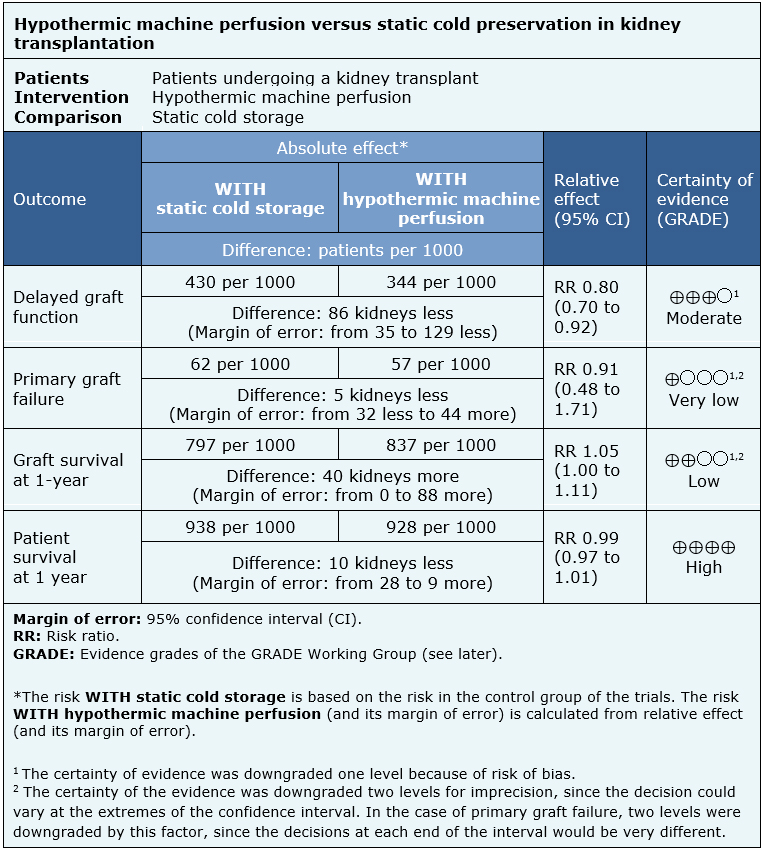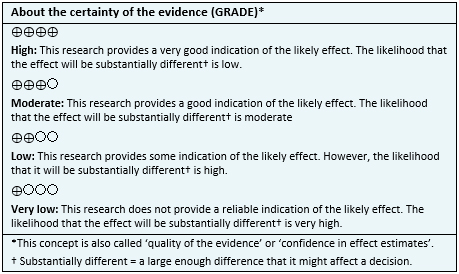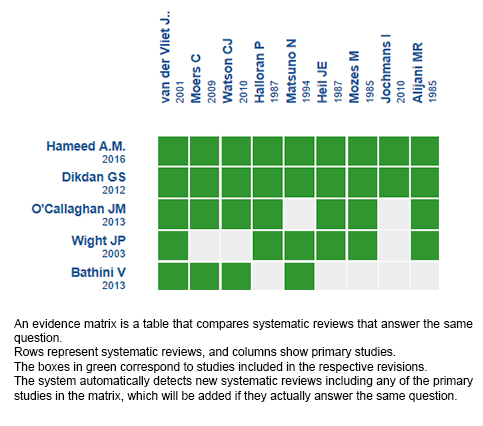Resúmenes Epistemonikos
← vista completaPublicado el 30 de noviembre de 2018 | http://doi.org/10.5867/medwave.2018.07.7359
Perfusión hipotérmica de máquina versus preservación en frío estático en el trasplante de riñón
Hypothermic machine perfusion versus static cold preservation in kidney transplantation
Abstract
INTRODUCTION The adequate preservation of the allograft prior to kidney transplant is key for a good outcome after transplantation. Currently, there are two main methods: hypothermic machine perfusion and static cold preservation. The main objective of this summary is to compare both preservation systems.
METHODS We searched in Epistemonikos, the largest database of systematic reviews in health, which is maintained by screening multiple information sources, including MEDLINE, EMBASE, Cochrane, among others. We extracted data from the systematic reviews, reanalyzed data of primary studies, conducted a meta-analysis and generated a summary of findings table using the GRADE approach.
RESULTS AND CONCLUSIONS We identified 10 systematic reviews including 34 primary studies, of which 13 were randomized trials. We concluded preservation by hypothermic machine perfusion probably decreases the risk of delayed graft function and could lead to a slight increase in graft survival. However, there are no differences in patient survival between the two methods.
Problem
There is an imbalance between demand and availability of organs for kidney transplantation, so strategies to increase the latter are required. One of them is to address organ preservation, in order to optimize the state of the kidneys prior to transplantation and achieve better post-transplant results.
Both hypothermic machine perfusion and static cold storage are alternatives for graft preservation prior to transplantation. Hypothermic machine perfusion generates a continuous pumping of perfusion solution to the renal parenchyma, which provides nutrients and oxygen, and removes toxins, theoretically decreasing damage derived from time of ischemia. Static cold is currently the most widely used method due to its greater availability, but the use of hypothermic machine perfusion has been increasing in recent years due to the change in donors profile, advances in technology and available perfusion solutions. It is relevant to determine which method is more effective in terms of post-transplant results.
Methods
We searched in Epistemonikos, the largest database of systematic reviews in health, which is maintained by screening multiple information sources, including MEDLINE, EMBASE, Cochrane, among others, to identify systematic reviews and their included primary studies. We extracted data from the identified reviews and reanalyzed data from primary studies included in those reviews. With this information, we generated a structured summary denominated FRISBEE (Friendly Summary of Body of Evidence using Epistemonikos) using a pre-established format, which includes key messages, a summary of the body of evidence (presented as an evidence matrix in Epistemonikos), meta-analysis of the total of studies when it is possible, a summary of findings table following the GRADE approach and a table of other considerations for decision-making.
|
Key messages
|
About the body of evidence for this question
|
What is the evidence. |
We found 10 systematic reviews [1],[2],[3],[4],[5],[6], |
|
What types of patients were included* |
Five trials only included donors with circulatory death [22],[25],[26],[42],[44]; four trials only included brain-dead donors [21],[23],[31],[43]; two trials included donors with both circulatory and brain death [12],[20]; one trial included brain-dead patients and expanded donor criteria [41], and one trial included patients with circulatory death, brain death, and expanded donor criteria [29]. |
|
What types of interventions were included* |
All trials compared hypothermic machine perfusion against static cold [12],[20],[21],[22],[23],[25],[26],[29],[31],[41] ],[42],[43],[44]. The type of perfusion machine used to perform hypothermic perfusion varied between the different trials. One trial used Waters/ Gambro [22], five trials used only Waters MOX100 [12],[21],[23],[31],[43], four trials used ORP LifePort [25],[41],[44],[29], one trial used only Gambro [42] and one trial used Nikkiso APS-02 [26]. There is no information regarding the type of machine used in one trial [20]. The different preservative fluids used in static cold also varied between trials. Four trials used the Euro-Collins solution [12],[20],[21],[31], seven trials used a solution from the University of Wisconsin [22],[26],[29],[41],[42],[43],[44] and one used Marshall's solution [25]. Only one trial did not specify which preservative solution for static cold was used [23]. |
|
What types of outcomes |
The trials measured different outcomes, which were grouped by the systematic reviews as follows:
|
* The information about primary studies is extracted from the systematic reviews identified, unless otherwise specified.
Summary of findings
The information on the effects of hypothermic machine perfusion compared to static cold preservation is based on 13 randomized trials that included 2122 kidneys [12],[20],[21],[22],[23],[25],[26],[29],[31],[41],[42],[43],[44].
All trials measured delayed graft function (2122 kidneys), eight trials primary graft failure (1719 kidneys) [20],[22],[26],[29],[31],[41],[42],[44], 10 trials graft survival at one year (2002 kidneys) [20],[21],[22],[23],[25],[29],[31],[41],,[42],[44] and six survival of the patient at one-year (1622 kidneys) [20],[22],[29],[31],[41],[44].
The summary of findings is as follows:
- Hypothermic machine perfusion probably decreases delayed graft function. The certainty of the evidence is moderate.
- It is not clear whether hypothermic machine perfusion decreases primary failure of the graft because the certainty of the evidence is very low.
- Hypothermic machine perfusion might slightly improve graft survival at 1 year, but the certainty of the evidence is low.
- Hypothermic machine perfusion results in little or no difference in survival of the patient at 1 year. The certainty of the evidence is high.

| Follow the link to access the interactive version of this table (Interactive Summary of Findings – iSoF) |

Other considerations for decision-making
|
To whom this evidence does and does not apply |
|
| About the outcomes included in this summary |
|
| Balance between benefits and risks, and certainty of the evidence |
|
| Resource considerations |
|
| What would patients and their doctors think about this intervention |
|
|
Differences between this summary and other sources |
|
| Could this evidence change in the future? |
|
How we conducted this summary
Using automated and collaborative means, we compiled all the relevant evidence for the question of interest and we present it as a matrix of evidence.

Follow the link to access the interactive version: Hypothermic machine perfusion versus static cold preservation in kidney transplantation
Notes
The upper portion of the matrix of evidence will display a warning of “new evidence” if new systematic reviews are published after the publication of this summary. Even though the project considers the periodical update of these summaries, users are invited to comment in Medwave or to contact the authors through email if they find new evidence and the summary should be updated earlier.
After creating an account in Epistemonikos, users will be able to save the matrixes and to receive automated notifications any time new evidence potentially relevant for the question appears.
This article is part of the Epistemonikos Evidence Synthesis project. It is elaborated with a pre-established methodology, following rigorous methodological standards and internal peer review process. Each of these articles corresponds to a summary, denominated FRISBEE (Friendly Summary of Body of Evidence using Epistemonikos), whose main objective is to synthesize the body of evidence for a specific question, with a friendly format to clinical professionals. Its main resources are based on the evidence matrix of Epistemonikos and analysis of results using GRADE methodology. Further details of the methods for developing this FRISBEE are described here (http://dx.doi.org/10.5867/medwave.2014.06.5997)
Epistemonikos foundation is a non-for-profit organization aiming to bring information closer to health decision-makers with technology. Its main development is Epistemonikos database (www.epistemonikos.org).
Potential conflicts of interest
The authors do not have relevant interests to declare.

